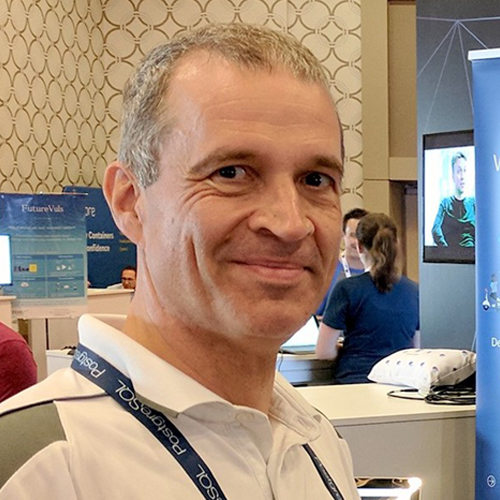On the lighter side of things, we ask Michael Meskes, Senior Director of Cloud Products, NetApp, what makes him tick.

What would you describe as your most memorable career achievement?
My most memorable career achievement is founding credativ together with a good friend in 1999. We were able to grow the company into an internationally known open-source specialist, helping our customers to better operate their open-source infrastructures.
We merged credativ with Instaclustr last year and I became the CIO. Instalcustr provides a SaaS platform for open-source technologies, using only the open-source versions of technologies like Apache Cassandra, Kafka, Redis, PostgreSQL and Cadence.
Things have gotten even busier since then: Instaclustr was recently acquired by NetApp, and I serve as the Senior Director of Cloud Products. It has been quite a year-and-a-half, and it has made that career moment of starting credativ back in 1999 more memorable in hindsight.
What first made you think of a career in technology?
I didn’t even consider a career in technology as a kid thinking about what I’d be when I grew up. Computers themselves were not yet commonplace so it wasn’t on my radar for a while. It was later on when I did finally get my hands on a computer, consistently, that I became deeply interested in IT. I was hooked and began looking forward to a career in it.
What style of management philosophy do you employ with your current position?
I believe that flatter hierarchies, open communication and leading as a close member of the team are the keys to cultivating a positive and successful company culture. Much like open-source, my team is itself an open community where any discussion or questions are welcome.
While the CIO or other tech leader can’t put out every piece of company information or collaborate on every decision, I’ve come to find that keeping communication as open as possible is tremendously beneficial. For my own part, I also make a point of remaining closely involved with development work on open-source projects, which keeps my feet on the ground as a team member.
What do you think is the current hot technology talking point?
Enterprises have absolutely embraced open-source data infrastructure like never before. That said, maintaining reliable, available, scalable, secure open-source projects requires thoughtful and knowledgeable support. As a technology leader, I take special care in ensuring that any open-source project we adopt is extensively vetted and that we’re ready to go all-in with our commitment to delivering support at a stellar level of quality.
How do you deal with stress and unwind outside the office?
I like to read, and I like to play golf. I’m a better reader than a golfer, but I find them both relaxing!
If you could go back and change one career decision, what would it be?
I can think of many small things I ought to have done differently, but I’m happy with where I am and how I arrived here, so I don’t really have any major career regrets to speak of. I was lucky in that my first-ever supervisor gave me the advice to focus on data and data processing, since that’s the core function of IT when it comes down to it. That advice has guided my career, which has been a pursuit of increasingly reliable and performant data processing technologies.
What do you currently identify as the major areas of investment in your industry?
Pursuing Digital Transformation and the open-source data-layer technologies best able to support that transformation is the key focus for enterprises and service providers alike. Open-source solutions are particularly well-suited to supporting Digital Transformations: they are certainly budget-friendly, they are easy to test drive and they represent some of the most efficient and scalable enterprise-grade technologies available.
For this reason, Instaclustr was built around pure open-source technologies, as opposed to ‘open-core’ solutions that are mostly just excuses to saddle customers with lock-in and steep license fees. My job has been to make sure the open-source projects we utilize deliver powerful results when it comes to helping customers achieve their Digital Transformation goals.
What are the region-specific challenges when implementing new technologies in North America?
I think that being afraid of the changes that come from implementing new technologies and thus instead sticking with well-known legacy systems is human nature and not all that much dependent on a specific area. But it seems to me that there is a correlation between companies attracting young and upcoming talent, and companies that are willing to implement new technologies over and over again.
I think what’s important here is that the correlation works in both directions: new talent is often needed to implement new technologies, but new technology also attracts new talent. It’s an important cycle for companies everywhere, to be able to modernize with the right new technologies and the right talent.
What changes to your job role have you seen in the last year and how do you see these developing in the next 12 months?
We want to increase our already robust involvement and contributions to the open-source communities we’re involved with. I believe that any business can improve its IT posture by enabling greater employee involvement in open-source projects, even where those solutions aren’t directly a part of their own technology stacks. At the same time, open-source communities and co-operation pay dividends, and you get out what you put in.
What advice would you offer somebody aspiring to obtain a C-level position in your industry?
Steep hierarchies are in opposition to my preferred management style, and I’m very glad to say they are disappearing across the industry. My advice is to embrace opportunities to lead as the first among equals and by your example. Be a good team member, motivating your team by working side-by-side within the same trenches. Also, really put yourself in their shoes and be the leader you would want to have.
Click below to share this article

